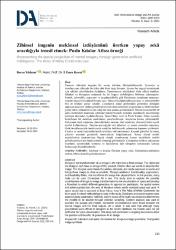Mimar Sinan Fine Arts University Institutional Repository
DSpace@MSGSÜ digitally stores academic resources such as books, articles, dissertations, bulletins, reports, research data published directly or indirectly by Mimar Sinan Fine Arts University in international standarts, helps track the academic performance of the university, provides long term preservation for resources and makes publications available to Open Access in accordance with their copyright to increase the effect of publications.Search MSGSÜ
Zihinsel imgenin mekânsal izdüşümünü üretken yapay zekâ aracılığıyla temsil etmek: Puslu Kıtalar Atlası örneği
Citation
Yıldırım, B., Kavut, İ. E. (2024). Zihinsel imgenin mekânsal izdüşümünü üretken yapay zekâ aracılığıyla temsil etmek: Puslu Kıtalar Atlası örneği. IDA: International Design and Art Journal, 6(2), 233-248Abstract
Tasarım zihindeki imgenin bir sonuç ürününe dönüştürülmesidir. İşverenin ve
tasarlayıcının zihninde bu ürüne dair birer imge bulunur. İşveren bu imgeyi tanımlamak
için sıklıkla sözcüklerden faydalanır. Tasarımcıysa sözcüklerle ifade edilen istekleri,
talepleri ve ihtiyaçları anlayarak bu iki imgeyi olabildiğince birbirine yakınlaştırır.
Estetik, işlevsellik, ergonomi ve uygulanabilirlik gibi filtrelerden yararlanan tasarımcı,
tasarım imgesini maddesel boyuta taşır. Süreçte faydalanılabilecek araç ve yöntemlerden
biri de üretken yapay zekâdır. Çalışmanın amacı görüntüden görüntüye dönüşüm
sağlayan araçların mekân görselleştirmesine olası katkılarını sorgulamak ve farklı üretken
yapay zekâ yaklaşımların yer aldığı bir akış şeması geliştirmektir. Mekân incelemeleri ve
şema üretiminde tasarlama eylemine benzer biçimde mekânın sözcüklerle tasvirlendiği
edebiyat alanından faydalanılmıştır. İhsan Oktay Anar’ın Puslu Kıtalar Atlası eserinde
betimlenen bir mekânın modelinden yararlanılmıştır. Araştırma karma yöntemdedir.
Çalışmada nicel araştırma yöntemlerinden tarama, nitel araştırma yöntemlerinden içerik
analizi kullanılmıştır. Tarama aracılığıyla veri tabanları ve arama motorları taranmış,
ölçüt örneklemesiyle incelenecek modeller belirlenerek çalışmanın kapsamı çizilmiştir.
Çıktılar ve model arayüzleri içerik analizine tabi tutulmuştur. Kaynak görseller ile sonuç
çıktıları arasında geometrik tutarsızlıklar bulgulanmıştır. Sonuç olarak model
arayüzlerinde tasarımcılara birçok olanak sunulmasına karşın modellerin mekân
görselleştirmesi için henüz yeterli olmadığı görülmüştür. Çalışmanın üretken yaklaşımın
tasarlama eylemindeki konumu ve faydalarına dair süregelen tartışmalara katkıda
bulunacağı düşünülmektedir. Design is the transformation of an image in the mind into a final product. The client and the designer each have an image of this product. Clients often use words to describe this image. The designer understands the wishes, demands, and needs expressed in words and brings these images as close as possible. Through aesthetics, functionality, ergonomics, and feasibility filters, s/he transforms the image into physical form. In this process, many tools can be used. Generative AI is one. The study aims to explore the possible contributions of image-to-image transformation to the visualization of space and develop a flowchart in which different generative AI approaches participate. For spatial review and schema production, the area of literature where words represent space was used. A space model that is depicted in İhsan Oktay Anar’s The Atlas of Misty Continents has been used. A mixed methodology is used in the study. Databases and search engines were scanned using quantitative methods, and the scope of the study was drawn by determining the models to be studied through criterion sampling. Content analysis was used to examine the outputs and models. Geometric inconsistencies were found between the source images and the final outputs. As a result, it was seen that although many possibilities were offered to designers in the model interfaces, the models were not yet sufficient for space visualization. The study will contribute to ongoing discussions about the position and benefits of generative AI in design. © 2024, Nilay OZSAVAS ULUCAY. All rights reserved.
Source
IDA: International Design and Art JournalVolume
6Issue
2Collections
- TRDizin [1118]
- Տcopus [1598]
- Ꮃeb of Science [1803]















